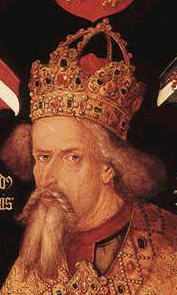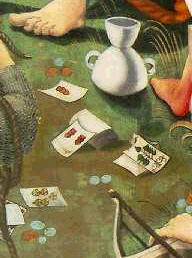1400 EGYPT:
A passage in Ibn Taghri-Birdi's "Annals of Egypt and Syria" (dealing with events of the year 1417-1418) mentions that the future sultan al-Malik al-Mu'ayyad won a large sum of money in a game of cards. This confirms that playing cards were known in Mamluk Egypt not long after they first appeared in Europe. The text reads:
"The reason for the seizure of the aforementioned Akba'i [the governor of Syria residing in Damascus] was that the Sultan al-Malik al-Mu'ayyad [reigned from 1412 to 1427] had, in the days when he was emir, purchased a youth for 2000 dirhams which he had won playing 'kanjafah' [or 'kanjifah']. Al-Malik al-Mu'ayyad was at that time a qa'id and he was playing cards with one of his comrades and had won many dirhams from this man. Then the aforementioned Akba'i was brought into his presence together with his dealer. He [al-Mu'ayyad] was taken with him and he purchased him. The dealer then sought out his [al-Mu'ayyad's] bursar in order to collect the price of the aforementioned Akba'i, but he could not find him; so al-Mu'ayyad himself paid him the price from the dirhams which he had won gambling..."
The name of the game -- 'Kanjafah' -- is apparently of Persian origin, and from this extract it can be seen that it was a gambling game involving high stakes. Al-Mu'ayyad was appointed emir in 1399, and elected sultan in 1412, and so the account refers to somewhere within these dates."
My Note:
My mother language is German and to me it's an easily acceptable idea, that a foreign spoken "kanjifah" or "kanjafah" could transmute in German language to Karnoeffel, or, as the game is called in contemperary manuscripts, Karniffel, Karnueffel and Karnoeffelins. The differences in German dialects are considerable and in older German, when written language still were searching for a real form and anybody wrote, as he personally heard and understood the words, the differences in writing were a logical result. Some general German was developed with Luther and printing industry (stronger in the protestant reigned countries), but minor differences in writing forms persisted till 18th/19th century.
Ka - n ji f ah
Ka r n i ff el
You don't hear in German language much of a "r before n" (for instance "Kaninchen" sounds like Karninchen, it's just a habit to write this Kan- and not Karn-), also you can't differentiate much between "f and ff" especialy when it is opening the final syllable at the end of a longer word). "ji and i" are different, but not far to each other (Ross Caldwell suggested that the ji in the original word might have turned to the "oe" sound), and "ah" and "el" are easily exchanged endings.
Ross Caldwell added the following consideration: "The first cards are known as Naibs (nayb etc.) It refers to a low court card, perhaps like the Unter. The Karnoeffel is the Unter - right? So there is a potential relation. But why would the German game have the "real" Arabic name for cards in general, while the Italians and Spanish made up a name never apparently used by Arabs?"
To the above question of Ross I developed the following plausible imaginations:
In playing card history it's general considered that playing cards wandered by imports to Italy or Spain. However, there is a third bridge between the Islamic world and Western Europe, mostly not very intensively considered: the Balkan.
In the historical situation the word "Karnoeffel" appears first 8-12 years after the council of Constance, in our opinion the great meeting place of different playing cards ideas in Europe. The most important and dominant person at the whole council was Emperor Sigismondo, who lead 3 popes to abdiction and created a new one. Sigismondo dominated especially the Eastern part of the German Empire, he had much to do with Poland, Bohemia and Hungary. Very early, 1496, then not having reached his state as emperor, he made serious experiences in the following context (from Wikipedia):
"Through his marriage to Mary, queen (1382-1385 and 1386-1395) of Hungary, Sigismund became the country's king in 1386 despite opposition among the nobility. In 1396 he organised a crusade to repel the Ottoman Turks, who were threatening Hungary from the south, but the Christian forces were routed at Nicopolis (now Nikopol, Bulgaria)."
Quite contradictionally another internet source reports: "When Beyazid, the son and heir of Murad, heard of the assassination of his father he went into a rage and ordered all Serbian captives killed. Beyazid became known as Yildirim, the lightning bolt, for his temperament. He conquered most of Bulgaria and nothern Greece in 1389-1395 though he suffered defeat at Nicopolis the 25th of September 1396 against the Venician-Hungarian army led by the Hungarian king Sigismund. The Ottoman campaign in Europe was halted. Beyazid then turned his attention to the east, conquering the turkish emirate of Karaman in 1397."
Independantly, if this was a "lost battle" or a "victory", it stands, that Sigismondo had opportunity in his early life to gather oriental influences, under them card playing influences (he was with military in the region, there are no better playing card transporters then soldiers). In the case, that a game called "kanjifah" was around at that time (probably a cultural bridge between Osmans and Mamelucks might be assumed), then Sigismondo or people around him had a good chance to get informations about it.
We've to look at the puzzling double naming of Karnoeffel or Keyserspiel (Emperor's game) - and additionally the council of Constance in 1414. At the council were important things to do - but of course a lot of free time to exchange cultural items, making music, playing cards, having some fun with the 1000s of prostitutes, which are reported to have been there, some hunting, some tournaments, a great spectacle full of great and minor events. If my suggestion is right, the men of Sigismondo brought with them a game (or cards), which they called "Karniffel" or similar. All the others participants, which were not familiar with that name for cards (or "game") - they used either "cartae" or "nayps" in various writing forms -, this was a new word and perhaps their tongue had difficulties to spell the word. They said "Emperor's game" and they meant with that "Emperor Sigismund's game", as he was the current emperor at the moment. By this the development of two names for the same game appears as rather naturally - and the whole context speaks for a relationship between the names Kanjifah and Karnoeffel.
Dummett relates "kanjifah" to the Indian term "Ganjifeh". The large distance between India and west-islamistic countries suggest a "stable word" in this region - it can't be excluded, that the word reached European countries, although modificated in local meaning and spelling.
Emperor Sigismondo visited Italy in 1433, he was imn Milano, where he didn't meet Filippo Visconti, who avoided a direct confrontation perhaps of fear of being killed, he was in Mantua and a result of this visit was the marriage between the local heir Ludovico Gonzaga (later called the Turk after the Congress of Mantua) and Barbara von Brandenburg, which established a longlasting marriage connection during various generations between Gonzagas and German princessses. He also visited Ferrara and knighted some persons there, also the just born babe Sigismondo D'Este, who got his name from the Emperor (and later became a rather addicted card player with heavy losses). A hidden result of this visit (in September 1434) was perhaps the new interest in playing cards in Ferrara (watchable since 1434, cards again imported from Florence), which had slowed down to nothing (at least to our eyes) since the death of Parisina and Ugo in 1425 (Parsina was known for her high interest in playing cards).
A second hidden result of the visit might have been a printing press for playing cards, which arrived under unclear conditions in 1436 in Ferrara. The most active person in this matter was the Mantovoano (somebody from Mantua, probably the printer) and the context it (perhaps) as follows: Leonello had married 1435 a daughter from Mantua, a sister of Ludovico the Turk. The fresh imported Barbara von Brandenburg, now wife of Ludovico the Turk, reassured "German connections" to the court of Mantua and part of these communications should have been the observation of German progresses in the art of playing card printing, which should have lead to an import of German technology to the court of Mantua, which was given by other marriage connections also to the court of Ferrara.
An 3rd hidden result might have been the production of Trionfi decks in Ferrara 1441/1442, which (perhaps never would have taken place, if Emperor Sigismondo hadn't visited Ferrara in 1433.


